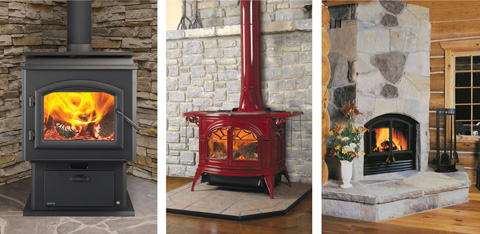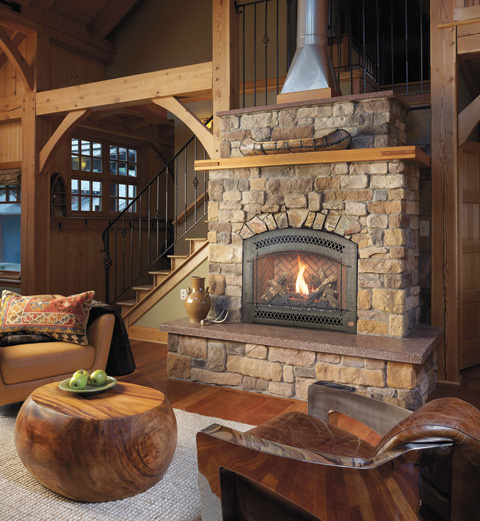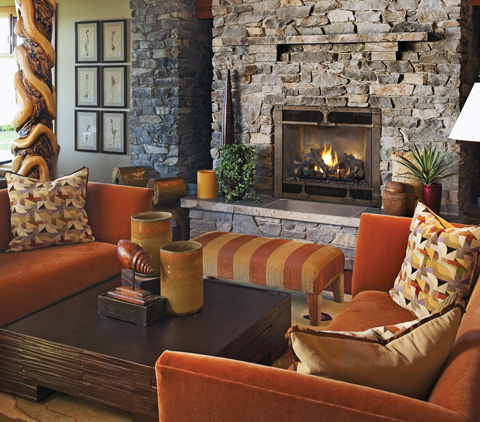The roaring fire with shadows dancing and welcoming warmth will always be a source of beauty and comfort for those who love log and timber homes. Whether providing a source of heat or decorative accent—or both—the fireplace and woodstove are essential elements in the look and feel of the home.
When it comes to that look and feel, the selection and efficiency of fireplaces and woodstoves is better than ever. Wood burning, gas, and electric alternatives are available from a variety of dealers and wholesalers and offer endless options as sources of heat and décor enhancements.
“Direct vent gas fireplaces are the ‘hottest’ thing in fireplaces today,” explains Clay Dennis, owner of Southern Hearth & Patio, a premiere fireplace and outdoor living retailer in Chattanooga, Tennessee. “As houses, especially log and timber homes, get tighter and tighter through increased insulation and other methods, interior air doesn’t exchange as often as it once did, and therefore the impact on air quality from ventless appliances due to hydrocarbons is far more suspect.”
“Direct vent brings in combustion air from the outside and exhausts byproducts back out,” Dennis continues, “leaving the interior air warmer but unaffected from fireplace operation. Similarly, I think open-faced wood burning fireplaces of the last 40 years may be going the way of the DoDo bird. New wood-burning fireplaces are sealed and operate more like woodstoves since having an open chimney is so inefficient when paying to seal up a home.”
Government regulation has significantly influenced the manufacture of woodstoves in recent years, and the 2015 EPA (Environmental Protection Agency) standards represent the third major regulatory revision since the 1990s. “Stoves that once produced emissions of 40 to 50 particles per million released into our atmosphere are long gone, and new regulations require stoves to produce emissions below 3.5. That’s a 10-times cleanup!” comments Clay. “Stoves today, by burning less wood much hotter, can also burn the stove’s gas emissions for added heat. Efficiencies are up from 35 to 40 percent to more than 75 percent. That’s less wood, less waste, and more heat.”

LEFT: The QuadraFire Adventure II Wood Stove features easily adjustable heat and clean burning. Center: Vermont Castings’ Defiant wood-burning stove can operate in catalytic and noncatalytic mode. RIGHT: The Opel wood-burning fireplace insert features low emissions, overnight burns, and high efficiency.
While modern and European fireplace and woodstove designs move more toward the mainstream, log and timber home owners are still drawn to the traditional look, says John Crouch, director of public affairs for the Arlington, Virginia-based Hearth, Patio, and Barbecue Association. “The open fireplace still remains the signature item in the great room, and log and timber homeowners are still drawn to that traditional look, but there are more contemporary looks out there for log and timber people who want to branch out.”
“One of the trends that I see is families moving toward more than one hearth in their homes,” Crouch adds. “They say that this is the home of their dreams and that they want more than one fireplace or woodstove, maybe even a small electric unit with a nice mantel. They often want to dress things up, and folks that are into unique designs like multiple fireplaces so they can create multiple looks. The key concept is that there are more choices out there than most people realize.”
Many log and timber home owners enjoy the appeal of the stone fireplace in the great room while placing smaller units in the bedrooms, home office, or even the kitchen for that “keeping room” atmosphere.
“We are continuing to see amazing electric fireplaces,” Crouch observes, “and people say, ‘That can’t be electric!’ but that’s the same thing that was said about gas years ago. These are not for the whole house, and they are strictly decorative. But they have a prettier flame than most people would think. Log and timber homes often have more than one way to keep warm, possibly propane along with woodstoves or fireplaces, allowing homeowners to be more creative with the decorative aspect.”
Fireplaces and woodstoves still offer the unique opportunity to enhance living spaces with an accent that is both aesthetic and cost efficient. “They are incredibly practical,” says Dennis. “As propane and fuel oil prices remain volatile from year to year, wood is a cheap, renewable, and clean option for home heating. Is the trend toward good looks, heating, or both? Both, but heat is the leader here. With efficiencies increasing, smaller appliances are creating more heat, which leads to conversations about comfort or discomfort. So, I’ve become super sensitive to correctly sizing fireplaces for their heating capabilities by square foot, rather than just their scale and size in the design realm.”

EPA-certified wood stoves are now available as stand-alone or built-in units. While the glass fronts are somewhat small, these design elements are popular in certain areas of log and timber homes while the open fireplace remains the focal point in a large gathering area. Gas fireplaces with the dual function of warmth and décor also feature heating controls for ambient temperatures, allowing the homeowner the flexibility to locate them in multiple rooms.
“EPA certification does mean that a woodstove is much more efficient than the stoves or open fireplaces of the past,” Crouch concludes. “That’s a reference to how clean burning the stove is. If you can burn the stove overnight it needs to be certified. If it is a decorative stove and you want to just enjoy the flames then it doesn’t have to be EPA certified.”
Since the focus with woodstoves in recent years has been on compliance with new regulatory standards, broader style options have kept pace as designers look to serve the environment and the consumer. “Most of the changes are here now, especially with wood,” Clay notes. “The EPA restrictions have both pushed engineering advances because of timeliness and stymied evolution because the focus had to be on the EPA regulations.”
With the implementation of the EPA guidelines, the possibilities continue to grow. “Woodstove sales may never be like they were in the 1980s again, but the technology for such a thing is now here,” he concludes. “I see the high-efficiency fireplaces as the next big thing. A woodstove that looks like a fireplace satisfies the need for a woodstove and the demand for new design.”
In choosing a fireplace or woodstove, the log or timber homeowner now has the luxury of picking and choosing on a grand scale. Available options offer the capability to serve as a primary or secondary heating option while also meeting the owner’s decorative preferences and expectations.

